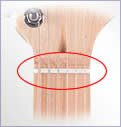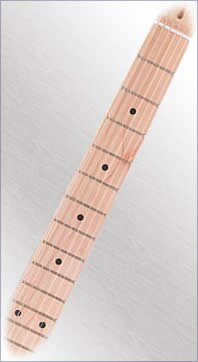
The Tuner / Tuning Machines
 |
The tuning keys are used to tune the strings. Turning the winder clockwise loosens the string and anticlockwise tightens it. If this is not the case on your guitar then there is a good chance your strings are put on wrong. This will not damage the guitar it just means that your guitar is not conformed to all others. |
Acoustic Tuner / Tuning Machines
 |
The tuning keys are used to tune the strings. On this guitar there are 3 on the top a 3 on the bottom. Strings are wound from the inside out on all machines. Turning the winder clockwise loosens the string and anticlockwise tightens it. If this is not the case on your guitar then there is a good chance your strings are put on wrong. This will not damage the guitar it just means that your guitar is not conformed to all others. |
The Nut
 |
The Nut consists of six grooves that hold the strings in position over the neck. It is usually made from plastic but some are made of graphite, steel or brass. |  |
The Neck & Fretboard
 |
The Neck holds the frets, usually 22 on electrics. Some guitars have as many as 24 (2 octaves) and as few as 17. The top of the neck is the area that the string is pressed to create a note. They usually have a dot or inlay that is used as a point of reference for moving your fingers along the fretboard. |  |
The Body
 |
The body holds the scratch plate, bridge, pickups, input socket, and tremolo bar, tone & volume pots. |
Acoustic Body
 |
The acoustic guitar body is hollow and it transfers the vibrations of the bridge to the air that surrounds it which produces the sound. The body also contains the scratch plate sound hole & bridge. |
The Bridge
 |
The bridge is located on the body and also contains the saddle which is used in conjunction with the nut to hold the string in place over the fretboard (neck). The bridge transfers sound from the strings to the body of the guitar. This can be held in place by screws or string tension. |
Acoustic Bridge
 |
A plate of wood or other material attached to the soundboard of a guitar, below the soundhole. The bridge anchors the strings and in conjunction with the saddle conducts the vibrations or energy from the strings into the soundboard and body. |
The Neck Pickup
 |
The neck pickup is found closest to the neck on the body of the guitar. Because of it position it receives a round full tone from the string. The neck pickup is usually used for jazz and blues styles. You can select the different pickups by using the pickup selector switch. |
The Middle Pickup
 |
The middle pickup is found in the center of the outer two pickups on the body of the guitar. Because of it position it receives a slightly more of a twang tone from the string. The middle pickup is generally used in conjunction with the neck or bridge pickup. You can select the different pickups by using the pickup selector switch. |
The Bridge Pickup
 |
The bridge pickup is found next to the bridge on the body of the guitar. Because of it position it receives a high twang tone from the string. This pickup is used mainly for distortion, rock and country. You can select the different pickups by using the pickup selector switch. |
The Input Socket (Jack)
 |
The receptacle the guitar cord is plugged into on the guitar and on the Amp. |
Pickup Selector Switch
 |
This is a 5 way selector switch, the 1st position (pushed all the way down) selects the bridge pickup, 2nd position selects the bridge & middle pickup, 3rd position selects the middle pickup, 4th position selects the middle and neck pickup and 5th position selects the neck pickup. |
Tremolo Bar or Whammy Bar
 |
Used to stretch or loosen the strings on a tremolo or vibrato system. This bar is attached to a tremolo bridge. By pushing it down you loosen the strings therefore dropping the tone of the string. It is mainly used in Rock or Country but was over used in 80’s glam rock bands like Whitesnake, Shid Row, Poison, Quiet Riot & Twisted Sister. |
Soundhole
 |
The soundhole is a large hole in the soundboard, usually directly under the strings, designed to increase sound projection. |
Scratch Plate or Pick Guard
 |
A scratch plate or pick guard is a very thin plate (usually made of synthetic material) glued to the soundboard below the thin string of the soundhole. It is there only to protect the finish from scratches and gouges (some manufacturers put pickguards on both sides of the soundhole). |



